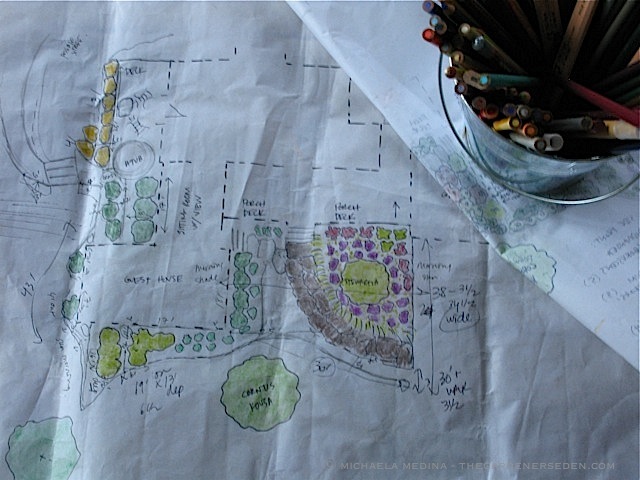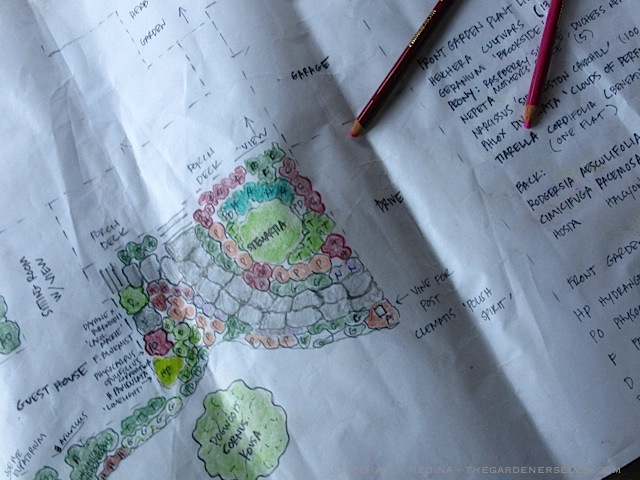Weaving Garden Dreams into Reality: The Art of Designing a Landscape …
 Sketching with Dahlias for Color Inspiration
Sketching with Dahlias for Color Inspiration
Rainy days are studio days. I’ve been indoors on this wet Labor Day, working on a bulb order for a garden I designed and planted last week, and putting together preliminary sketches for two upcoming projects. My painting studio doubles as my garden design space; filled with all of the supplies you would expect in an artist’s work room. On my desk, drafting tools and calculators mingle with watercolors, colored pencils and pastel chalk. Plant encyclopedias and a laptop are close at hand, as are nursery stock lists and contractor phone numbers. There’s a view of the entry garden and steel balcony from my studio, but I always bring a few flowers to my desk for inspiration, whenever I’m working indoors …
 The Original Design Drawing, Presented to the Homeowners (My original design included four different shrubs in the back border. The owner has a strong affection for blue hydrangea, so the final design eliminated the varied shrubs in favor of H. macrophylla ‘Endless Summer’)
The Original Design Drawing, Presented to the Homeowners (My original design included four different shrubs in the back border. The owner has a strong affection for blue hydrangea, so the final design eliminated the varied shrubs in favor of H. macrophylla ‘Endless Summer’)
Some of my clients —particularly those more familiar with my work— commission garden designs from me without requiring preliminary drawings or plant lists. They just wave their hands around to show where they want improvements and give me a few dos, don’ts and budgetary guidelines. And sometimes —when I’m both designing and installing a garden— a basic sketch and plant list is all that my client requests. But when a project is larger and involves subcontractors —stoneworkers and other hardscaping— I always do sketches, full-scale drawings and planting plans with complete lists. Late last year, I almost caved in to industry ‘Sketch Up’ pressure. Why buy a program to create drawings when I can do them myself? Well, to some, the results of computer-generated design programs are great selling tools; after all, they look slick and impressive. I suppose they inspire confidence. But are they really better? After playing around with ‘Sketch Up’ for a week or so —although I thought it was quite cool and useful— in the end I decided that I genuinely prefer hand drawing garden designs and planting plans. I like sketching out what I see in my imagination … I find that it informs my creative process. And you know what? When I mentioned this to one of my clients —who’s garden design you see featured here— I discovered that my drawings are part of what attracted her to my work.  And after a thorough survey of my wonderful clients, I found that they prefer my hand-made drawings over generic-looking, computerized mock-ups; some have actually framed them.
 I Don’t Have Trouble Seeing Three Dimensional Space. But, Drawings Help Me to Communicate What I See in My Mind’s Eye
I Don’t Have Trouble Seeing Three Dimensional Space. But, Drawings Help Me to Communicate What I See in My Mind’s Eye
 Before: A Pretty House with a Blank Canvas for This Garden Designer. Large Scale Design Drawings Helped My Clients Visualize Proposed Changes
Before: A Pretty House with a Blank Canvas for This Garden Designer. Large Scale Design Drawings Helped My Clients Visualize Proposed Changes
 With a drawing like the one directly above, I can show my client exactly what my garden design will look like when it matures. I can also use an overlay (done on vellum) to show where a foreground tree will be placed. Call me old-fashioned, but as much as I am a computer person, I still adore books and I will always love paper.
With a drawing like the one directly above, I can show my client exactly what my garden design will look like when it matures. I can also use an overlay (done on vellum) to show where a foreground tree will be placed. Call me old-fashioned, but as much as I am a computer person, I still adore books and I will always love paper.
Once my client approves a design —drawings always help with visualization— I set to work on scale planting plans. These plans help me to space plants properly and order the correct number of plants. Of course, there’s always tweaking to be done in the end —that’s half the fun of garden design, really— but planting plans are dimensionally correct keys, allowing me to come up with estimates and stay on budget. All of the plants are drawn into the plan at their mature size to insure correct spacing, and they are represented by their approximate shape and leaf color (or bloom color). Sometimes, a subcontracted landscaper or a client will install part or all of the garden I design, and in such cases, it’s critical that all of this information be clearly communicated. Usually there are multiple revisions and many copies …
 Preliminary Site & Planting Plan I
Preliminary Site & Planting Plan I
 Secondary Site & Planting Plan, II (there is yet another, final plan for this project)
Secondary Site & Planting Plan, II (there is yet another, final plan for this project)
A detailed site plan and list of materials also helps with financial decision making; allowing me to estimate costs for hardscaping, nursery stock and installation. I use dimensions and plant counts to calculate the amount of compost/loam, mulch and the number of plants I need for a project. Once the final plan and budget are approved, the site plan and plant lists serve as a guide when purchasing trees, shrubs and perennials at nurseries. A copy of the site plan is also on hand during layout and planting. Even if I don’t create a complete set of watercolor or pencil drawings, I always create a basic site plan when I am designing a garden; even one of my own.Â
 As Plants Go In, Overturned Pots Hold the Places of Those Yet to Arrive. A Stewartia pseudocamilla Anchors the Center of This Semi-Shade Garden
As Plants Go In, Overturned Pots Hold the Places of Those Yet to Arrive. A Stewartia pseudocamilla Anchors the Center of This Semi-Shade Garden
 The Back Deck is Softened by a Sweep of Fountain Grass (Pennisetum alopecuroides)
The Back Deck is Softened by a Sweep of Fountain Grass (Pennisetum alopecuroides)
 The Curve of the Perennial Border Echoes the Natural Stone Walkway and a Dogwood (Cornus x rutgan ‘Stellar Pink’) Softens the Corner of the House
The Curve of the Perennial Border Echoes the Natural Stone Walkway and a Dogwood (Cornus x rutgan ‘Stellar Pink’) Softens the Corner of the House
I’ll be back with more photos of this project when it’s completed. Plus, stay tuned for how you can create and use a planting plan to modify an existing, or design your own new garden …
Photos and Text â“’ Michaela Medina/The Gardener’s Eden. All photographs, articles and content on this site, (with noted exceptions), are the original, copyrighted property of The Gardener’s Eden and may not be reposted, reproduced or used in any way without prior written consent. Contact information is in the left side bar. Thank you!
Do you enjoy The Gardener’s Eden? You can help support this site by shopping through affiliate links (including Amazon book links). A small percentage of each sale will be paid to this site, helping to cover web hosting and maintenance costs. Thank you so much for your support!
8 Replies to “Weaving Garden Dreams into Reality: The Art of Designing a Landscape …”
Comments are closed.

It’s nice to see how the planning comes together! I am guilty of buy now, plan (and plant!!) later. Trying to break that habit… but not there yet!
So I am curious, do you ever design remotely, where the customer sends you all the needed informations and pictures?
Michaela,
This is amazing. I have a friend who is a landscape designer, and I knew there had to be a lot of planning involved, but to read about how you go about it, the detail (and time!) involved, was really educational. But there is much more than education here. You have a real gift for writing, and obviously for drawing. I only recently learned through reading some of your posts that you paint in the winter months. I find it fascinating how many creative people have more than one area of creativity — often multiple areas, as obviously you have. Yet not all of us manage to expand on the variety of things we might be interested in. And certainly not everyone manages to find, as Robert Frost put it, a vocation which is also an avocation. It is really wonderful to read how you do some of that, and I wanted to thank you for sharing this. It really got me thinking about a lot of things, and I was very interested to see your drawings and the planning process. Also, I am one of those who still loves the tactile beauty of books, pens, paper. I am able to enjoy some of that with the photographic cards I make. I also have quite a collection of books. There is a lot to be said for technology, and I earn my living working online, but I was glad to see that you still use handmade drawings for your work. As you said, obviously your clients value that as well. This is a long comment, but your post was really packed full of things. Wonderful.
@ Jen – Well, let me be honest, I sometimes buy now and plant/plant later too. But I only allow myself to do that in small quantities. Usually I can find a spot within a pre-prepared bed (or, I sometimes play musical perennial). Overall, planning helps with the big picture. However, I’m all for tweaking and improv once the framework is set! ;) Above all, have fun out there! xo M
@ Jenny – Yes, I have remotely designed and/or assisted with design work from a distance before. It is, as you might imagine, quite challenging. It requires a couple of things to begin with: that the installer/gardener be skilled at both gardening and reading planting plans (or able to get skilled help) and that they follow through with excellent measurements and site photos. It’s not the optimal situation, of course, but it can actually work. The best way to do it is to have the design helper on site. But in a remote location, that’s not always possible. ;) M
@ Terry – Thank you so much for the thoughtful comment! I am fortunate indeed to have found work I love which utilizes my skills and passions. The hardest part of doing so many things is, well, doing so many things! I wish I could find more hours in my day to create, create, and create some more! It makes me so very happy to know that this post was informative and fun to read. I’m also fascinated by the fact that although you work on a computer, you also continue to be drawn to the physicality of paper, drawings and books. Perhaps we all need that physical, sensual realm. Comments like yours really keep me going, because they let me know what posts are best liked and why! So thank you again. I’m so glad you enjoyed this peek into my process. I’ll be writing more about garden design, and working directly with new gardeners during installation, soon! xo M
If you have some time would you like to take a walk in the orchard?
@ Zeke – Oh my goodness, the answer to that question is always YES! :)